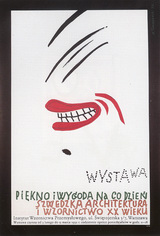The poster of Henryk Tomaszewski can be seen as a new form of seeing the world and reality. The poster, “Beauty and comfort for every day,” can be seen as a unique symbol of happiness and good mood, positive emotions, and feelings. The poster depicts a smile and contours of a face. Thus, it is not a simple smile: it is bear teeth and a grin. The contours are not clear, and viewers can only guess that it’s a face and a chin (depicted as a dot). Tomaszewski does not use bright colors for this poster but uses only red, white, and black. These colors are symbolic and underline the similarity and triviality of an image. In this poster, the perception depends on relativism, by which the artist views the truth itself and creates intellectual frameworks of the judging subject. To attempt to define the smile is to defy the perception of joy and happiness of its main principles – which is to deny that final or true definitions are possible because even the most plausible candidates will always invite a further defining move, or ‘play,’ with language (Henryk Tomaszewski 2008).

The graphic shapes are simple and only resemble a human face. It is difficult to say the gender, race, age, or background of a person depicted on the poster. It can be a man or a woman, a tall young man or a tiny lady. Thus, it is not a smile of a child as it reflects some aggressiveness and craftiness. There are no small details except an explanation at the right-hand corner of the poster. “Wystawa” means theatrical performance. Tomaszewski writes all messages and the name of a poster in black letters to underline the trivial nature of the poster (Henryk Tomaszewski: Biography 2008). This poster is framed with black contour, so it makes an impression of a picture or photograph of a smile.
The message is clearly transferred to a viewer who interprets it on the basis of the image and the title. Most importantly, the viewer involved in the articulation or interpretation of this poster should act independently of any supposed intentions of the artist. Attention to an artist would privilege quite the wrong thing, for seeing him or her as an origin, or a delimiting authority, for the meaning of the text was an obvious example of the privileging of a particular set of meanings. The plausibility of this way is to see texts as forms of rhetorical meaning. The artist sees the image as containing a number of perpetually competing stories, whose effectiveness depends not so much on an appeal to an independent standard of judgment as upon their appeal to the communities in which they circulate. Tomaszewski tries to communicate a message that all people pretend in their life smiling and being pleasant in order to meet general, behavior standards, and principles of communication. Thus, the word “Wystawa” suggests that a smile is often insincere and two-faced. Of course, it is possible to point out such ideology-undoing internal contradictions without claiming at the same time to have an overall alternative solution to society’s problems. Language systems will be found to contain contradictions because they are essentially metaphorical. Not surprisingly, this aspect appealed immensely to viewers, who could apply themselves to any material, and not just to those texts, particularly poems, or historical periods, which pretty well asked for their contradictions to be revealed. This poster can be understood by a person from every country and culture, and the poster transcends cultural boundaries. The language and conventions of the image became something to play with.
Works Cited
Henryk Tomaszewski. Poster Gallery. 2008. Web.
Henryk Tomaszewski: Biography. Polish Culture. 2008. Web.